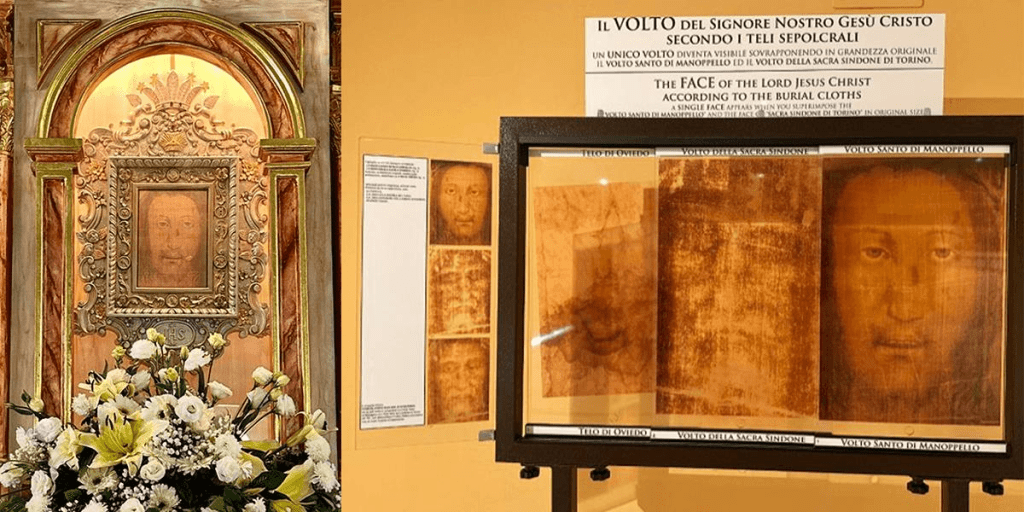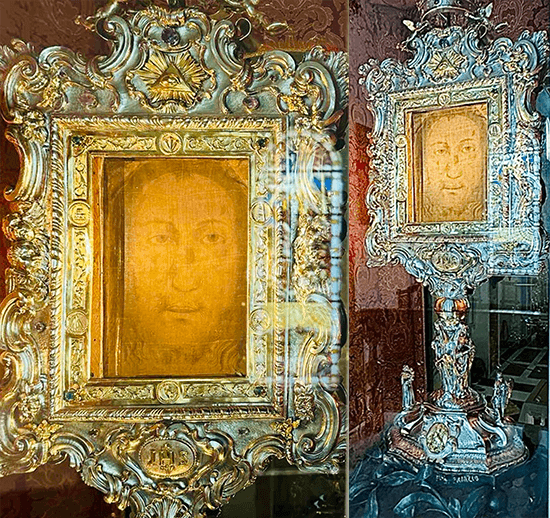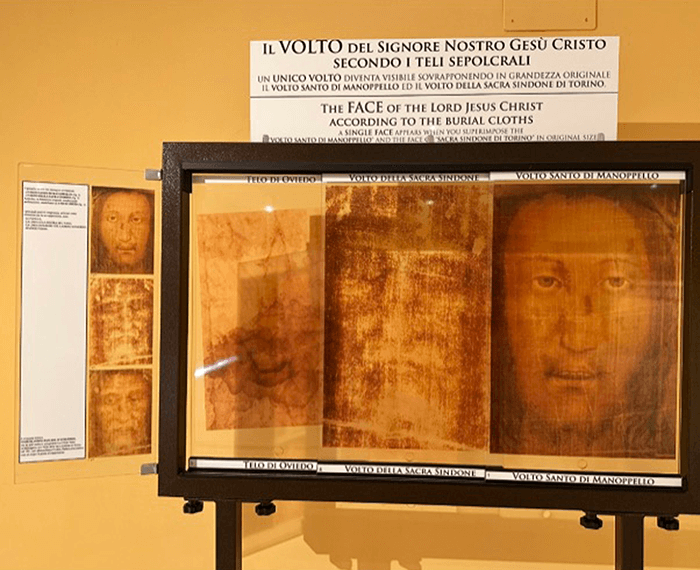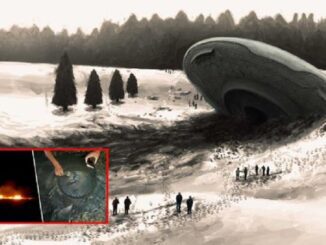
For Christians, to see the Face of Christ is the ultimate goal if one gets to heaven. But how about the possibility of getting a glimpse of it here and now?
There is a holy relic cared for by the Capuchin Franciscan Friars in a place in Italy called the Basilica Santuario del Volto Santo di Manoppello. It is an image of the face of Jesus, imprinted on a small burial cloth that covered his face as he lay in the tomb.

The original Veil of Manoppello. It is in a simple wooden frame, which in turn is placed inside a grand reliquary. It was said the veil was once removed from its wooden frame which caused the image to disappear.
How it got there was quite a journey.
Fr. Bonifacio “Ted” Lopez and Cardinal Chito Tagle recount what they know of the Veil of Manoppello.

A display at the museum shows how the face of Jesus on the Shroud of Turin and the Veil of Manoppello are completely matched in size and shape when superimposed upon one another.
When the Lord died, there was a cloth or handkerchief positioned on his face, along with the shroud that wrapped his entire body. After three days, he resurrected, and the powerful force of this event caused his image to be imprinted on the shroud and on the veil. Scientists cannot explain it. It is not pigment, paint or ink.

An image has likewise been installed in Our Lady of EDSA Shrine at the corner of OrtigasmAvenue and EDSA, Quezon City, last Dec. 22, 2024 on the occasion of Father Ted’s 30th sacerdotal anniversary.
The rare cloth is made from the fine hair of seashells, called byssus. It is so fine—three times thinner than human hair. It is waterproof. It can be dyed but cannot be drawn upon.
It traveled from Jerusalem to Constantinople, San Giovanni, and then to Rome at the old St. Peter’s Basilica. (In 1506, the new St. Peter’s Basilica was being built and around this time, the veil was kept away), but by 1527 during the sack of Rome, it was lost.

However, some accounts say that in 1506, people were talking about this mysterious man, some say an angel, who brought the veil to the Church of San Niccola in Manoppello.

He gave it to one of three men talking nearby, Giacomantonio Leonelli, who was told to take care of it as this would bring blessings to his family and the town of Manoppello. As Giacomantonio opened the handkerchief, the man disappeared. It was kept safe with his family for over a century.

One of the Leonelli heirs had a husband who was jailed, and she sold the veil to buy his freedom. It was the town chemist, Donatantonio de Fabriziis, who bought the relic and eventually donated it to the friars after they had cleaned and cared for it.
The friars allowed the public to view the veil from 1638 onwards.

It was once referred to as the Veil of Veronica—the cloth used to wipe the Lord’s face when he was carrying the cross to Calvary. But it was later discovered that the name Veronica is a contraction of the Latin words vera icona, meaning true image. Veronica, who is not mentioned in the Bible, is possibly a legend of tradition.
It was a visit by Pope Benedict XVI in 2006 that would revive interest in the veil. He then elevated the status of the Santuario to a Minor Basilica.
* * *

This can’t be real,” Father Ted said to himself. He suspected the veil was probably just a hoax concocted by the early Catholic Church to generate income. He even observed that the face was not a good rendition—not a handsome, ideal image of Christ.

Many times, Father Ted had been invited on mission trips to the United States as interpreter to promote the devotion to the Holy Face. Father Carmine Cucinelli, Rector of the Basilica Volto Santo, would deliver his homily in Italian, explaining about the Veil of Manoppello, and Father Ted would be expected to translate this into English.

Having been sent to study in Italy since he was 15 years old, he was quite out of practice in the use of the English language and was not confident he could do it. After declining several times, he finally relented when he could no longer escape the assignment.
To say he was nervous was an understatement. He could not sleep. For four months. As if the Lord was speaking to him, he would conspicuously see everywhere the verse “Do not be afraid.” It was written in the gift card on his fruit basket at the hotel. It was on the statue of Pope St. John Paul II as he descended from the car into the church. He even dreamed of the Holy Face smiling at him, telling him “Do not be afraid.”
And then, came the time of reckoning. As Father Carmine spoke, Father Ted could hear in his mind—clear as a bell—his own voice, dictating the very words to say in English! He could not even hear the voice of Father Carmine for whom he was supposed to be translating!
Humbled and grateful for the gift of divine aid, Father Ted was determined to promote the devotion to the Holy Face. He has since overseen the installation of numerous images of the Holy Face in churches and parishes in Italy, the Philippines and North America. So many serendipitous events would unfold in the process, it was undeniably the hand of God at work. And when he speaks about it through laughter and tears, his eyes light up like a child in awe over the faithfulness of the Lord who gave him the experience to believe.
* * *
Cardinal Chito had a beautiful insight about the Holy Face. We, as Christians, wish to look like Christ, to have the face of Christ.
It was Manuel Tagle, Cardinal Chito’s younger brother and affectionately called Kuya Nonoy, who introduced us to the devotion to the Holy Face. He gave us a lenticular prayer card that when turned at an angle, displays simultaneously the Veil of Manoppello and the Shroud of Turin —showing how they are perfectly aligned.

It was surprising how little I knew about this. It was something I was hopeful to see for ourselves someday.
A visit to Father Lorenzo Ruggiero, a friend and beloved Rector of the Santuario della Divina Misericordia in Pescara, Italy, finally allowed us the opportunity to go to nearby Manoppello.
Manoppello is a quiet town, devoid of crowds, rows of souvenir shops or large tour buses. The residents here seem calm in the knowledge that there is a miraculous relic in their midst.

The church sits on top of a hill. It seems it was purposely meant to be there, apart from the world—where one can have an encounter with the Lord, unhurried and in silence.

This was the moment. Seeing the veil just a few inches away from my own face, immediately the mind races: analyzing the object, the weave of the cloth, the image—what is it? Does it appear to be drawn with graphite? On something like piña fiber? But this is not made by human hands! A material and spiritual battle ensues within.
And then there is this face, looking at me with the gentle tenderness of hope. His mouth is partly open, as if taking his first breath. And I no longer see with the mind but hear with the heart. He speaks, “I am the Resurrection.”


